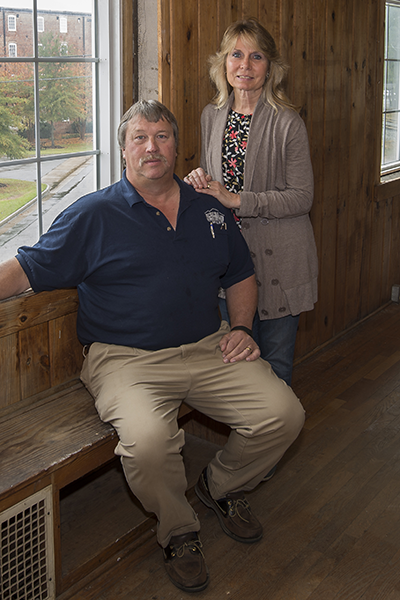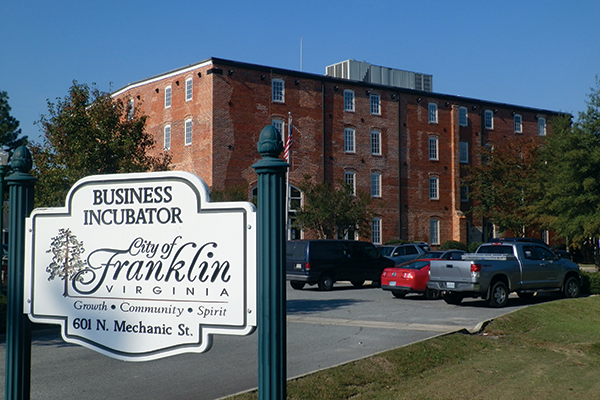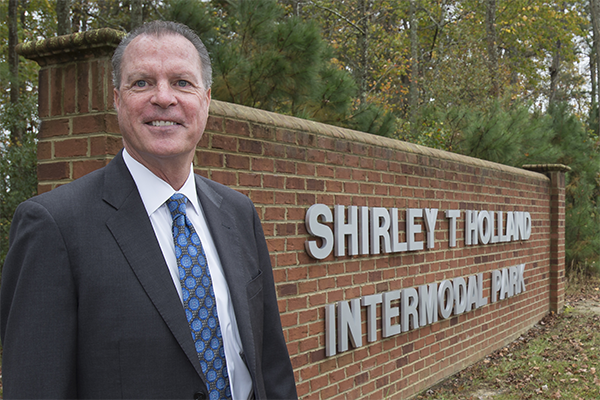Regional resilience
Rural area rebounds from floods and layoffs
Beth Cooper //November 30, 2015//
When you are a small engineering services firm headquartered in a small city, the news that your primary customer is closing down is likely to be a devastating blow.
Highground Services Inc., however, fought back and has actually flourished in the six years since International Paper announced it was shuttering its Franklin mill and laying off 1,100 workers. “You wouldn’t think our largest customer going out of business would be a good thing,” says CEO James Strozier. “But it forced us out of our comfort zone and made us go out and find additional business and allowed us to hire some really talented people.”
Today, Highground Services has more than 60 employees, including many former International Paper workers, and a client list that includes Huntington Ingalls Industries, Smithfield Foods and Elizabeth River Crossings.
 Highground Services illustrates the resilience found in Franklin and its neighbors in Southampton and Isle of Wight counties. Nestled on the western edge of Hampton Roads, these rural communities have faced an array of challenges over the past two decades.
Highground Services illustrates the resilience found in Franklin and its neighbors in Southampton and Isle of Wight counties. Nestled on the western edge of Hampton Roads, these rural communities have faced an array of challenges over the past two decades.
The 2010 mill closure just over the Isle of Wight County line followed major floods in 1999 and 2006 that devastated downtown Franklin, while the 2013 sale of Smithfield Foods Inc. to a Chinese conglomerate left many worried that Isle of Wight’s top employer would relocate its meat-processing operations.
Frustrations and uncertainties, however, have given way to renewed optimism. The region is forging innovative economic development endeavors and embracing new corporate and residential citizens while remaining committed to its agricultural roots.
“This region has really suffered over the past 15 years,” acknowledges Amanda C. Jarratt, president and CEO of Franklin Southampton Economic Development Inc. “But the community is incredibly resilient. They’re truly hungry for new investments and have reinvented themselves.”
That hunger compelled Franklin and neighboring Southampton County to merge their economic development efforts 10 years ago and their planning, inspection and zoning departments in 2013. “It’s a forward-thinking idea that has benefited both communities,” Jarrett says. “The two communities are so dependent on each other that, in certain areas, it makes sense to collaborate. It’s really unique that there’s a willingness to be regional on a small level.”
 Franklin Southampton Economic Development oversees the 10-year-old Franklin Business Incubator, which provides office space and equipment, conference rooms and mentoring to new businesses. Twenty-two startups currently lease space in the facility, a 45,000-square-foot, century-old converted buggy factory. They typically remain in the incubator for five to seven years before going out on their own. “The business incubator is really a shining star,” Jarrett says.
Franklin Southampton Economic Development oversees the 10-year-old Franklin Business Incubator, which provides office space and equipment, conference rooms and mentoring to new businesses. Twenty-two startups currently lease space in the facility, a 45,000-square-foot, century-old converted buggy factory. They typically remain in the incubator for five to seven years before going out on their own. “The business incubator is really a shining star,” Jarrett says.
Twelve companies have graduated from the incubator, with the majority moving into their own offices throughout the region. “Some businesses go to Suffolk or Chesapeake,” Jarratt notes. “That’s OK. We don’t always have the real estate they need, or they find their market is not in Franklin.”
Highground Services will move out of the incubator next year after completing renovations on the former Franklin Power and Light office, which the firm purchased from the city. That’s a win-win on all fronts, says Jarratt. “It’s adding a building back to the tax rolls that has not been taxed in 30 years, and it’s keeping the company here.”
For Strozier, there was no question the firm would remain in Franklin. “I’ve lived here 30 years,” he says. “We’re rooted here and have had a lot of community support.”
He also likes the small-town atmosphere. “We don’t have traffic jams or commuting issues, and it’s easy to do business with local people. If I need some type of support, I know who’s available.”
Jarratt, who grew up in Windsor in Isle of Wight, returned to the area four years ago and is optimistic about its ability to attract new industry. She points to Enviva, a wood-pellet production company, which opened a facility in Southampton County four years ago, and Hampton Farms, which launched an almond butter and peanut butter production plant this year. “We’re a business-friendly and environmentally caring community,” she says. “We definitely have new industry coming into the market. I’m excited about the future.”
New industry has helped drive down the unemployment rate. Franklin’s unemployment peaked at 12.6 percent in 2010, but fell to 6.5 percent in September. Southampton County’s unemployment rate reached 8.6 percent in 2010 but had dropped to 3.9 percent in September. Unemployment in Isle of Wight rose to 7.1 percent in 2010 but had fallen to 4.2 percent in September.
International Paper’s return to the market in 2012 helped reduce unemployment rates. It refitted part of its mill for fluff fiber production and hired about 250 employees. ST Tissue repurposed another portion of the mill as a recycled-tissue plant employing 85 workers, and former International Paper employees purchased the company’s sawmill, hiring about 75 employees.
 Meanwhile, Smithfield Foods, still Isle of Wight’s largest employer with about 1,500 workers, reported record results for 2014, with $15 billion in revenue. The sale of Smithfield Foods turned out to be a nonissue, says Tom Elder, the county’s economic development director. “Every conversation I’ve had with Smithfield Foods, Larry Pope [its CEO] has emphasized that they’re not going anywhere. They love being on the banks of the Pagan River.”
Meanwhile, Smithfield Foods, still Isle of Wight’s largest employer with about 1,500 workers, reported record results for 2014, with $15 billion in revenue. The sale of Smithfield Foods turned out to be a nonissue, says Tom Elder, the county’s economic development director. “Every conversation I’ve had with Smithfield Foods, Larry Pope [its CEO] has emphasized that they’re not going anywhere. They love being on the banks of the Pagan River.”
Smithfield Foods fits in well with Isle of Wight’s tagline — “Local Roots, Global Reach.” “Local roots is the pride we have living here and is reflective of the rural nature of our economy,” Elder explains. “Yet, we’re marketing it on an international basis.”
A major selling point is the county’s proximity to the Port of Hampton Roads. “Accessibility to the port is a big asset for us,” Elder notes. The 1,500-acre Shirley T. Holland Intermodal Park, 24 miles from the port, is home to three national companies — retailer Cost Plus World Market, office furniture manufacturer Safco Products Co. and coffee roaster Keurig Green Mountain. Together, they employ more than 700 people. Still, the park has not added any new tenants since signing Green Mountain in 2011. To spark interest, the county is investing $17 million in shovel-ready sites, which would allow businesses to be operational within months of signing a lease.
The proposed rerouting of the new U.S. 460, however, could pose a problem. The park was built outside Windsor to be easily accessible to the new highway, but environmental studies by the Army Corps of Engineers showed the route would adversely impact wetlands. New plans now place the park miles from the nearest interchange. Elder, though, is not worried — yet. “I don’t know if that project is actually going to happen any time soon,” he says.
With a population currently hovering around 36,500, Isle of Wight is on track to have more than 40,000 residents by 2030. The population has grown by 15.5 percent in the past decade, making it the third fastest-growing locality in Hampton Roads and the 21st fastest in the state. “We’re a very large county with lots of available property,” Elder notes. “We provide an alternative living to urban living — affordable properties in a nice, quiet environment.”
Elder’s five- to 10-year goals for Isle of Wight include additional development in the intermodal park, as well as residential and commercial growth in the Newport Development Service District between Smithfield and the Suffolk line.
But tensions have simmered as residents fear residential and commercial growth will lead to suburban sprawl and erode the county’s small-town atmosphere. This past summer, after considerable public outcry, the Isle of Wight Board of Supervisors voted down the county’s controversial ISLE 2040 growth plan for the Newport district outside Smithfield.
County Administrator Anne Seward says ISLE 2040 addresses challenges facing the county, including costly water contracts with Suffolk and Norfolk, budget deficits, lack of economic development, a diminishing workforce and a scarcity of retail and entertainment venues. Opponents, however, contend that the plan would lead to overdevelopment. Seward says the board will take another look at ISLE 2040. “Hopefully, people will understand the challenges,” she says. “Nobody is trying to harm any community. We have to make the best out of the cards we’ve been dealt.”
Keeping younger residents in the rapidly aging county has been especially challenging because of limited job and affordable housing options. “Kids graduate and move away to where they can get jobs, affordable housing and amenities,” Seward says. She adds that additional workforce housing will attract new industries and commercial developments, keeping tax dollars in the county. “Businesses look for population to support them,” Seward says. “A business that locates just outside the county adds to our residents buying in other communities and helping to keep their taxes low, not ours.”
To help recoup lost revenue, Isle of Wight has proposed extending water services to the Gatling Pointe subdivision currently served by the Town of Smithfield. Seward says adding the James River community would offset costs of the county’s water contracts while staving off potential annexation by Smithfield. “We have six times the amount of water that we’re actually using,” she says. “Over the course of 40 years, we will pay over $200 million for water. If we don’t have a plan to stimulate our customer base, we’re going to have problems.”
Smithfield opposes Isle of Wight’s bid to take over Gatling Pointe’s water service. “We’ve been servicing Gatling Pointe since the late ’80s, so the county’s plans to extend water came as a surprise,” says Town Manager Peter Stephenson. He adds that Smithfield has no plans to annex Gatling Pointe. “Annexation is always a potential, but it’s something that we’re not actively pursuing.”
Smithfield’s slogan of “Hams, History, and Hospitality” plays on its ties to Smithfield Foods, as well as its heritage — the town was established in 1752 — and its Southern charm. “It’s a great small town. There’s something for everybody,” Stephenson says, noting that Smithfield is the top day-trip destination for Williamsburg visitors.
He ticks off a list of Smithfield’s attractions, including its downtown, listed on the National Register of Historic Places, and Windsor Castle Park. Developed five years ago, the 208-acre park features a fishing pier, kayak and canoe launch and nature trails. The land was originally on property owned by Smithfield’s founder, Arthur Smith IV. Joseph W. Luter III, the former CEO of Smithfield Foods, donated $5 million to the town in 2009 to buy the property and an additional $2.2 million to develop the park.
Isle of Wight also is counting on its public school system in its bid to attract more industry and residents. The school system ranks 14th among the state’s 131 school divisions and first in South Hampton Roads, according to SchoolDigger.com. All of the county’s nine schools are accredited, with the division boasting a 93 percent on-time graduation rate.
James Thornton, who came on board as school superintendent in July, said the successful schools backed by strong community support drew him to Isle of Wight. “There are a very large number of experienced teachers in Isle of Wight whose stability and experience provide backbone and strength,” he says.
Thornton plans to build on those strengths as the division prepares to implement a STEM (science, technology, engineering and mathematics) initiative for fourth through eighth grades. “We’re not looking for just a program,” he notes. “We’re looking to fully integrate STEM within our curriculum.”
That’s a plan that Seward hopes will result in more graduates staying in Isle of Wight. “We have a beautiful community,” she says. “The fact that we’re a smaller community means we have to protect those things that are very important to us. Ultimately, we will always have to be looking forward but keep those things that are sacred to us.”
r














